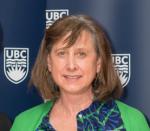Sabbatical Leave, Stanford Linear Accelerator Center (05-06)
Professor, U British Columbia (05-present)
Associate Professor, U British Columbia (97-05)
Assistant Professor, U British Columbia (93-97)
IPP Research Scientist & Adjunct Assistant Professor, based at CERN, Switzerland, affiliated with U Victoria (90-93)
Postdoctoral Research Fellow, Caltech (87-90) (research at SLAC)
Graduate Student,U of Toronto, Research based at DESY in Hamburg, Germany (82-87)
NSERC Summer Student UBC/TRIUMF (summer 82)
Eidgenösisches Institüt für Reaktorforschung, Würenlingen, Switzerland (summer 81)
Atomic Energy of Canada Ltd, Chalk River (12 months, 79-80)
IBM Canada, Toronto (8 months, 78-79)
- UBC Faculty of Science Achievement Award for Service, 2013
- Killam Prize for Excellence in Teaching (2005)
- Izaac Walton Killam Memorial Fellowship (2002-3)
- Charles A. McDowell Award for Excellence in Research(1999)
- NSERC Women's Faculty Award (1993-98)
- EC Stevens Scholarship (U of Toronto) (1986-87)
- Junior Fellow, Massey College, U of Toronto (1982-83), (1985-87)
- Graduate student research at DESY lab, Hamburg, Germany (1983-85)
- NSERC PGS Scholarship (1982-86)
- Bell Canada Full Undergraduate Tuition Scholarship (1977-82)
- 1st year Honours Advisor (10-present)
- Undergraduate 3rd & 4th Year Advisor and 1st year Honours Advisor (17-22)
- Undergraduate 2nd Year Advisor (10-22)
- Undergraduate Recruitment (08-) Chair
- New Faculty Hiring Committee (07-19) Co-chair
- Undergraduate Program, UBC Dept Physics & Astronomy (07) Chair
- Graduate Program, UBC Dept Physics & Astronomy (00-05) Chair
- Graduate Admissions, UBC Dept Physics & Astronomy (99-00) Graduate Admissions Committee
- UBC Dept Physics & Astronomy (99-05) Departmental Executive Committee
- UBC Dept Phys & Astro (01-05)
- Many new faculty hiring committees (>20 in past 15 years)
- Past-Chair, Chair, Chair-Elect, Vice-Chair, Northwest Section of the American Physical Society (00-04)
- Vice-Chair, Chair, Division of Particle Physics, Canadian Association of Physicists (95&96)
Beachcombing, hiking, swimming, gardening, kayaking, skiing and cycling with my kids.
BirthPlace: Montreal, QC
Experimental Collaborations
Argus (DESY) 1983-87
Mark-II (SLAC) 1987-1990
OPAL (CERN) 1990- 2002
BaBar (SLAC) 1993- present
Belle II (KEK) 2019 - present
Research Interests
While we have no reasonable Grand Unified Theory incorporating gravity with the other 3 forces, we have succeeded in uniting the weak and electromagnetic forces in a theory we refer to as the Standard Model of Electroweak Interactions with the strong force described in a similar gauge framework of Quantum Chromo-Dynamics (QCD).
Experiments I'm currently working on critically test the Standard Model of Electroweak Interactions, and could possibly lead to experimental evidence of new physics, physics beyond the Standard Model.
 BaBar Experiment
BaBar Experiment
Physics of the b quark is just on the verge of its most exciting and interesting times, with the exploration and perhaps understanding of CP-violation just around the corner. A high luminosity B-factory has been completed at the Stanford Linear Accelerator Center and we are persuing an aggressive program studying and understanding the origin of CP-violation. At the BaBar Experiment at the PEP-II storage ring in Stanford, California we are investigating the phenomena of CP-Violation by examining a huge number of B meson decays and have discovered and are presently study CP-violation in the B system. We hope to further our understanding of the origin of the matter-antimatter asymmetry of the universe. Most consistent Big-Bang theories predict equal parts of matter and antimatter in our universe. However, no experimental evidence exists for any places in our universe that are mainly antimatter, rather than matter, and hence a big question in particle physics today, is where has all the anti-matter gone? We have a bit of a potential lead: in rare decays of neutral kaons, we have seen evidence for a tiny amount CP violation.. that is decays in which there is a matter-antimatter asymmetry. But it is hard (seemingly impossible!) to use this tiny violation of CP symmetry and incorporate it into a consistent theory to explain the vast matter-antimatter asymmetry of our universe within the Standard Model. Such an asymmetry may potentially be accommodated within the Standard Model via quark couplings specified in the CKM matrix. So at SLAC, we are making and reconstructing the production and decay of millions of B mesons/year, and are making progress in gaining some insight and full understanding of the phenomenon of CP-violation. Starting in 1993, B physics studies, detector R & D, online software and physics simulation for the BaBar drift chamber have been the main activities of our group, and in summer of 99, we started taking data. Present specific analyses center on semileptonic B decays, measuring CKM matrix elements and decreasing background contamination in lepton samples. I've been Secretary of the Babar Speakers Bureau for >8 years, and Babar Council member.
 Belle-II Experiment
Belle-II Experiment
Belle II is an e+e- collider experiment at SuperKEKB in Japan, and is a follow up on the Babar and Belle CP and heavy flavour physics - operating at the same energies as BaBar and Belle, but with more than 100 times the luminosity. Belle II is performing high precision measurements of heavy flavour beauty, charm and tau decays and has potential to discover new physics beyond the Standard Model via searches for rare decays and new particles. The UBC Belle II group is working on the commissioning and data collection of Belle II and is contributing to reconstruction software development, calibration, feature extraction, and commissioning of the Belle II electromagnetic calorimeter and high level trigger. Belle II Canada is providing the photon background monitoring system.
Various recent newsclips
- Killam Memorial Fellowship Award in UBC Reports, 2001
- McDowell Medal Award in UBC Reports, 1999
- NSERC announcements in UBC Reports, 1999
- UBC year's honours in UBC Reports, 1999
https://inspirehep.net/authors/998031
Students asking for Letters of Reference, see: http://www.physics.ubc.ca/~janis/LettersReference.html
